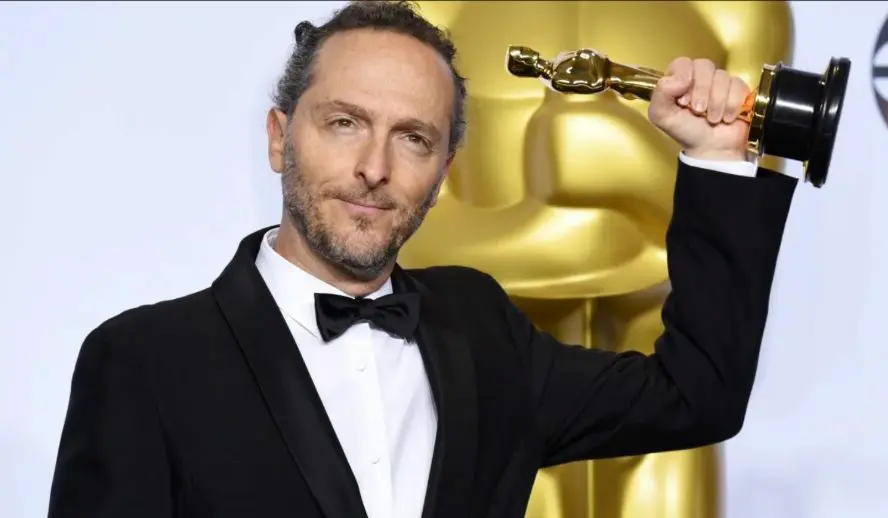Table of Contents
The Humble Beginnings of a Master
Emmanuel Lubezki is one of the most decorated cinematographers currently working, having garnered three back-to-back Academy Awards for Best Cinematography — an unprecedented feat and something of a victory lap for a man who had become highly sought after by the time the 2010s rolled around. Cinematographers often take the back seat compared to the directors they work alongside, but Lubezki has the privilege of both being a gifted cameraman and having collaborated with some of the finest filmmakers in or out of Hollywood: Alfonso Cuarón, Alejandro González Iñárritu, Terrence Malick, Tim Burton, the Coen Brothers, just to name a few.
Lubezki started out, perhaps most consistently, as Cuarón’s go-to cinematographer, with their careers basically starting out conjoined at the hip; with Cuarón’s debut feature, ‘Sólo con tu pareja,’ in 1991, Lubezki was unleashed upon the world — only not quite. He would work with Cuarón on several more films during the ‘90s, from ‘A Little Princess’ (which nabbed Lubezki his first Oscar nomination) in 1995 to ‘Great Expectations’ in 1998. Lubezki would see his second nomination for Tim Burton’s ‘Sleepy Hollow’ in 1999. Although Burton’s super-dark take on the Washington Irving short story is gorgeously heightened in its aesthetics, we don’t see the hallmarks of Lubezki’s style yet; we would have to wait until he was a good deal deeper into his career.
Things to do:
- Subscribe to The Hollywood Insider’s YouTube Channel, by clicking here.
- Limited Time Offer – FREE Subscription to The Hollywood Insider
- Click here to read more on The Hollywood Insider’s vision, values and mission statement here – Media has the responsibility to better our world – The Hollywood Insider fully focuses on substance and meaningful entertainment, against gossip and scandal, by combining entertainment, education, and philanthropy.
‘Children of Men’ (2006)
Remember ‘Children of Men’? I didn’t, for a long time. Alfonso Cuarón’s near-future sci-fi thriller was a box office disappointment, but over time, it’s become one of the most well-regarded genre films of the 2000s — in no small part due to Lubezki’s astounding camerawork. While Terrence Malick’s ‘The New World’ (released the previous year) looked stunning in its own right, it was with ‘Children of Men’ that Lubezki’s signature style would bloom fully, namely his fondness for long flowing takes. Without getting too specific, in the interest of spoilers, there’s an iconic sequence in ‘Children of Men’ where our heroes are in a car — and so is the camera. However, the action heats up when a gang of bandits ambushes the car, and the action alternates between the inside and the exterior — in a single shot that lasts three or four minutes. ‘Children of Men’ is not exactly an action movie, but the ingenuity of Lubezki’s work gives it more energy than most, which properly fits the genre.
WATCH THE TRAILER of the Film and the Revolution: ‘Can I Go Home Now?’
The Children Around the World Continue to Ask the question
‘The Tree of Life’ (2011)
Lubezki was somewhat productive in the 2000s, picking up two more Oscar nods along the way; it was a real turning point for him in that not only would he produce some of his best work with Cuarón, but he would also start his fruitful relationship with Terrence Malick. True enough, ‘Children of Men’ and Malick’s ‘The New World’ would supply the two extra Oscar nominations, and in my humble opinion, Lubezki should have won for ‘Children of Men’ — all due respect to Guillermo Navarro for his work on ‘Pan’s Labyrinth,’ of course. Speaking of nominations that should have been won, Lubezki went on a sort of mini-hiatus after working on ‘Burn After Reading,’ one of the more overlooked Coen brothers movies, returning in 2011 with Malick’s ‘The Tree of Life.’ A little personal, but I remember watching ‘The Tree of Life’ a good decade ago with my mother, and neither of us understood what was happening; it was an impeccable work of visual storytelling, though, especially in Lubezki’s freely flowing camerawork and the mostly practical effects by the late Douglas Trumbull. ‘The Tree of Life’ is the kind of movie that deserves its own retrospective piece someday, but for now, I’ll say that if you go into it as a purely emotional experience and not as a conventional film narrative, you won’t be disappointed.
Related article: – Want GUARANTEED SUCCESS? Remove these ten words from your vocabulary| Transform your life INSTANTLY
Related article: ‘Pan’s Labyrinth’: Innocence and Moral Disobedience in Guillermo del Toro’s ‘El laberinto del fauno’
‘Gravity’ (2013)
As impressive as ‘The Tree of Life’ is, though, Lubezki’s first Oscar win would come along with his most frequent collaborator — Alfonso Cuarón, who himself was coming out of a rather lengthy hiatus. ‘Gravity’ isn’t talked about too much nowadays, I suspect because it’s the kind of movie that’s inexplicably connected to the big screen; you would have to have seen it either in a theater or on the biggest TV you can manage. While it’s certainly more of a visual effects showcase, the cinematography of ‘Gravity’ is no slouch — indeed hosting one of Lubezki’s most impressive long takes in its opening sequence, a shot which lasts about twelve minutes. Most of the film is a one-woman show, with Sandra Bullock performing what feels like a lopsided dance with the elements of space, replicated convincingly both through the VFX and the elaborate camera rig used to give one the impression of movement in zero gravity. While it has naught but the bare bones of a plot, ‘Gravity’ is undoubtedly a technical marvel, winning awards pretty much everywhere for its visual effects, sound design, directing (being Cuarón’s first Oscar win for Best Director), and cinematography, with Lubezki getting his first Oscar.
Related article: EVOLUTION: Every Ryan Gosling Role From 1995 to 2020, All Performances Exceptionally Poignant
Related article: EVOLUTION: Every Henry Cavill Role From 2001 to 2021, All Performances Exceptionally Poignant
Related article: Stumble Through the Jungle With Sandra Bullock and Channing Tatum in ‘The Lost City’
‘Birdman’ (2014)
The 2010s would see Lubezki hopping back and forth between the directors he clearly loves working with most, from Malick’s ‘To the Wonder’ in 2012 to what would earn him his second Oscar win, with Alejandro González Iñárritu’s ‘Birdman or (The Unexpected Virtue of Ignorance)’ in 2014. Iñárritu had previously made waves in the arthouse world with award winners like ‘Amores perros’ and ‘Babel,’ but ‘Birdman’ would be his breakthrough in the mainstream. With an all-star cast (including a surprisingly intense performance by Zach Galifianakis) and a genre-bending screenplay that turned its vengeful eye on the rise of superhero movies, ‘Birdman’ was all but destined to be a critical darling. The central gimmick of the film, that being the illusion of it all being shot in a single take, was achieved in takes roughly fifteen minutes apiece, with most of the action being set in the rooms and floors of a theater. While it’s easy to write off the gimmick as just “showing off” for Lubezki and Iñárritu, the theatrical location invokes an all-in-one-take approach; it’s like watching a live performance without any cuts or fade-outs. Lubezki’s disembodied camera works in tandem with Antonio Sánchez’s percussion-heavy jazz score to give us a movie that (love it or hate it) feels entirely like its own beast.
Related article: Understanding the Star Wars Timeline
Related article: A Tribute to Francis Ford Coppola: One of Cinema’s Unforgettable Directors | ‘Megalopolis’, ‘The Godfather’ & More
Related article: #metoo Revolution: Powerful Questions That Need Answers
Related article: FACT-CHECKED Series: Timothee Chalamet and 32 Facts about The Young Superstar
Related article: A Tribute To Ewan McGregor: The Superstar-Actor Known for Iconic Roles
‘The Revenant’ (2015)
With ‘Birdman,’ Lubezki became the undisputed master of camera movement, and his streak continued with his follow-up; well, he actually had three films out in 2015. Firstly, we have Malick’s ‘Knight of Cups,’ a largely unscripted fever dream that strips away what little plot ‘The Tree of Life’ would’ve had. Next is ‘Last Days in the Desert,’ a Biblical movie about Jesus’s forty days in the desert, which (despite Ewan McGregor’s spirited lead performance) is little more than a pit stop for Lubezki. No, the big release of 2015 would be Lubezki’s next collaboration with Iñárritu: ‘The Revenant.’ Whereas ‘Birdman’ was a fantastical drama-comedy, ‘The Revenant’ is a brutal and ice-cold Western, more in the tradition of James Fenimore Cooper’s “Leatherstocking Tales” than your typical John Wayne movie. Like with ‘Birdman,’ however, there is a gimmick at play here which shows Iñárritu and Lubezki testing their skills — this time, a strict call (with one or two exceptions) for naturalistic lighting. Lubezki shot ‘The Revenant’ with virtually no artificial lighting, instead relying on certain hours of the day to achieve the soft lighting and hazy look we would see in the finished product. Despite behind-the-scenes drama on set and a budget that inflated basically to blockbuster levels, ‘The Revenant’ won awards for Lubezki and Iñárritu, with Lubezki winning his third consecutive Oscar for Best Cinematography.
Related article: Top 10 South Park Characters | Who Makes the Cut? Kenny, Chef, Butters, Towelie, Eric?
Related article: In-Depth Analysis | The Unexpected Queerness of ‘Bob’s Burgers’: Why the Show is an Animated Ally
Related article: How Do A-List Stars Justify Working With Self-Confessed Sexual Harasser David O. Russell Who Abused His Own Niece?
The Hiatus and The Recent Project
After ‘Song to Song’ (which had been shot years earlier) in 2017, Lubezki more or less went silent; the 2010s were a highly prolific time for him, never mind the back-to-back Oscar wins. Lubezki had already taken a three-year break between ‘Burn After Reading’ and ‘The Tree of Life,’ so this was not unprecedented — even so, Lubezki’s absence in the final years of the 2010s was sorely felt. However, after five years, he returned as the director of photography for David O. Russell’s feature, ‘Canterbury Glass.’ Not only was Russell directing, but Hildur Guðnadóttir (known for her work on ‘Joker’ and ‘Chernobyl’) was in charge of the score.
Emmanuel Lubezki has been active in the field for over thirty years and has been a master for at least the past fifteen. While he showed himself to be more than just “competent” from the start, it took a while for him to find his own style — the quick and fluid camera movements, the long takes, the sense of naturalism that permeates even the most outlandish premises. There’ve been many great cinematographers throughout Cinema’s history, including several who are currently among us, but I can’t think of any (not even the great Roger Deakins) who are as flashy and relentlessly kinetic as Emmanuel Lubezki.
Click here to read The Hollywood Insider’s CEO Pritan Ambroase’s love letter to Cinema, TV and Media. An excerpt from the love letter: The Hollywood Insider’s CEO/editor-in-chief Pritan Ambroase affirms, “We have the space and time for all your stories, no matter who/what/where you are. Media/Cinema/TV have a responsibility to better the world and The Hollywood Insider will continue to do so. Talent, diversity and authenticity matter in Cinema/TV, media and storytelling. In fact, I reckon that we should announce “talent-diversity-authenticity-storytelling-Cinema-Oscars-Academy-Awards” as synonyms of each other. We show respect to talent and stories regardless of their skin color, race, gender, sexuality, religion, nationality, etc., thus allowing authenticity into this system just by something as simple as accepting and showing respect to the human species’ factual diversity. We become greater just by respecting and appreciating talent in all its shapes, sizes, and forms. Award winners, which includes nominees, must be chosen on the greatness of their talent ALONE.
I am sure I am speaking for a multitude of Cinema lovers all over the world when I speak of the following sentiments that this medium of art has blessed me with. Cinema taught me about our world, at times in English and at times through the beautiful one-inch bar of subtitles. I learned from the stories in the global movies that we are all alike across all borders. Remember that one of the best symbols of many great civilizations and their prosperity has been the art they have left behind. This art can be in the form of paintings, sculptures, architecture, writings, inventions, etc. For our modern society, Cinema happens to be one of them. Cinema is more than just a form of entertainment, it is an integral part of society. I love the world uniting, be it for Cinema, TV, media, art, fashion, sport, etc. Please keep this going full speed.”
More Interesting Stories From The Hollywood Insider
– Want GUARANTEED SUCCESS? Remove these ten words from your vocabulary| Transform your life INSTANTLY
– A Tribute to Martin Scorsese: A Complete Analysis of the Life and Career of the Man Who Lives and Breathes Cinema
– Do you know the hidden messages in ‘Call Me By Your Name’? Find out behind the scenes facts in the full commentary and In-depth analysis of the cinematic masterpiece
– A Tribute To The Academy Awards: All Best Actor/Actress Speeches From The Beginning Of Oscars 1929-2019 | From Rami Malek, Leonardo DiCaprio To Denzel Washington, Halle Berry & Beyond | From Olivia Colman, Meryl Streep To Bette Davis & Beyond
– In the 32nd Year Of His Career, Keanu Reeves’ Face Continues To Reign After Launching Movies Earning Over $4.3 Billion In Total – “John Wick”, “Toy Story 4”, “Matrix”, And Many More










